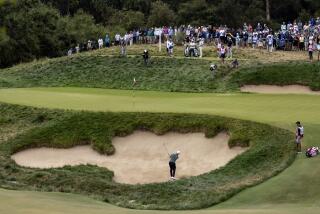A Fair Way to Go : There’s Work to Be Done on Pelican Hill’s Second 18
NEWPORT COAST — As the yellow John Deere earthmover takes another swipe at what will be the seventh fairway of the Pelican Hill Links course, it’s hard to link this vision of wounded earth with pastoral images of golf.
The earthmover, a “scraper” in construction lingo, is roughly shaping the fairway, which will split in half to give golfers a choice of paths to the green. With each pass, the scraper takes a bite that lowers the fairway and leaves symmetrical scars.
Watching this scene is George Druzisky, the director of agronomy for Pelican Hill Golf Club. An observer mentions that there seems to be quite a bit to do to prepare the course for the expected mid-November opening.
“Yeah, I lie awake at night wondering if it’s going to happen,” Druzisky said with a weary chuckle.
It was only partly a joke--there are a multitude of tasks for Druzisky, who is responsible for maintaining everything that grows on the course, before the first tee time is reserved--but the course is more complete than this view would indicate.
The Nos. 1 and 18 holes were finished before the club’s first course opened in November, 1991, and all but seven of the remaining fairways have been sodded with plush Bermuda grass. The schedule calls for the fairways to be laid with sod by the end of August and the greens, which need longer to grow in, to all be seeded by the first week of August.
None of this, of course, will be on the minds of the first paying foursome when they reach the seventh hole and each golfer has to decide which fairway to play on the 448-yard, uphill par-4.
If one were to turn around to ponder the choice, he would see a panoramic view of the Pacific Ocean--the Balboa and Newport Beach piers to the right and the coastal cliffs of Laguna Beach to the left.
It’s an awesome sight--and site for a golf course.
That is exactly what the Irvine Company figured when it decided to build two premium public golf courses as the centerpiece of its multimillion dollar Newport Coast development.
The first 18 holes, the Ocean course, is into its second year of operation and is nearly booked solid, despite the that fact that its green fees ($125 on weekends; $105 during the week) are the highest in Orange County.
The success of the $30-million Ocean course prompted the completion of the Links course, on which construction was halted in the summer of 1991.
The courses originally were scheduled to open simultaneously but the economic downturn forced a delay. Plans for two luxury hotels adjacent to the courses were also scrapped for the time being because of the soft hotel market.
So Pelican Hill is essentially a resort course without the resort. Still, it was honored as the best new resort course of 1992 by Golf Digest magazine and it has become a destination of its own, luring business people from pricey local hotels and inducing others to give up their country club memberships.
With the opening of the second 18, which will have the same green fees, comparisons are bound to be drawn. However, other than having the same architect--noted golf course designer Tom Fazio--the two courses have little in common.
Among the major draws of the Ocean course are the four holes on the bluffs above the Pacific on the ocean side of Pacific Coast Highway. The Links course has nothing similar, but because it is set higher up the coastal foothills, its vistas are more expansive.
Whereas the landscaping of the Ocean course was made lush by planting some 4,000 mature trees, the Links’ look is more spare.
It’s a far cry, however, from a rolling, barren traditional links course such as Royal St. George’s, where the British Open was recently held.
“It isn’t really a true links course,” said Kevin Sutherland, a Fazio architect who has been at the site full time since December. “In my understanding of the term, links land is an area of land that connects the sea to where everybody usually lives in the British Isles. It is sandy, dunes type land with a lot of native grasses, low growing shrubs and no trees.
“That kind of rolling terrain--that feeling of ups and downs and more open wind-swept feeling--was partly the derivation of the name for our links course.”
Like its British ancestors, the course has been designed to blend with the surrounding terrain. Much of the vegetation in the canyons has been left untouched and in many of the non-fairway areas, where grading was necessary, native plants have been reintroduced.
Cart paths, an unsightly necessity to the Fazio group, have been hidden and trees have been planted along the edges of the course to shield players from views of neighboring back yards. Provisions have also been made for large galleries that would attend professional tournaments.
“We would prefer to have a golf course where players don’t see anything but the course and the natural part of the land,” Sutherland said.
Aesthetics are important but they aren’t the main concern, and as much attention has been paid to making sure the course plays well.
At its longest, it will play 6,859 yards, more than 200 yards longer than the Ocean course from the back tees. It also will have smaller greens and Sutherland said that combination probably means it will be a bit tougher.
“The real trick is by the way we use angles, create a harder golf course from the very back tees and still not change it for the average golfers,” Sutherland said.
It’s the average golfer whom Fazio aims to please with his courses. He tries to make a course challenging without it being frustrating.
“I believe that a majority of golfers play golf on the ground,” Fazio said. “So I think it’s extremely important when designing golf courses to allow people openings and angles to the green.”
Even so, the harsh terrain forced the issue on the Links course. Two of the par 3s require tee shots that carry a canyon.
“You either make it or you don’t, and you drop another ball in the drop area. Sometimes people are critical of that stuff, and I guess it’s a fair complaint if there is too much of it,” Sutherland said. “But if you could roll the ball to the green with your putter on every hole, that would get boring.”
The 17th hole, a 540-yard par 5, is more forgiving. A sweeping, subtle dogleg that hugs a canyon wall on the left, it’s also one of the more picturesque.
The safety-minded player can hit shots into the slope of the canyon wall. Those more daring can cut across the lake off to the right of the fairway. In the distance, a lone Toyon tree appears etched against the horizon next to the green.
On a recent afternoon, two stray balls from the driving range rested in the middle of the 17th fairway, seemingly waiting for a player to take aim at the flagstick. The hole appears ready to go.
Fazio, himself, is more than ready for the course to open.
“I’m nervous,” he said. “I’m anxiously awaiting the real test. We can tell you a million things about how good the course is, but our golfers are going to tell us what kind of job we’ve done.”
More to Read
Go beyond the scoreboard
Get the latest on L.A.'s teams in the daily Sports Report newsletter.
You may occasionally receive promotional content from the Los Angeles Times.










